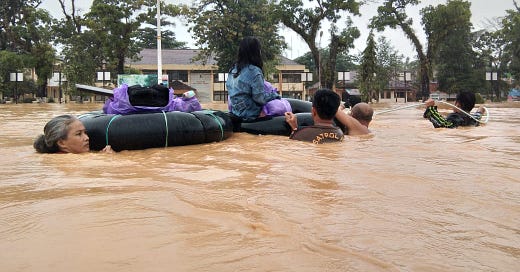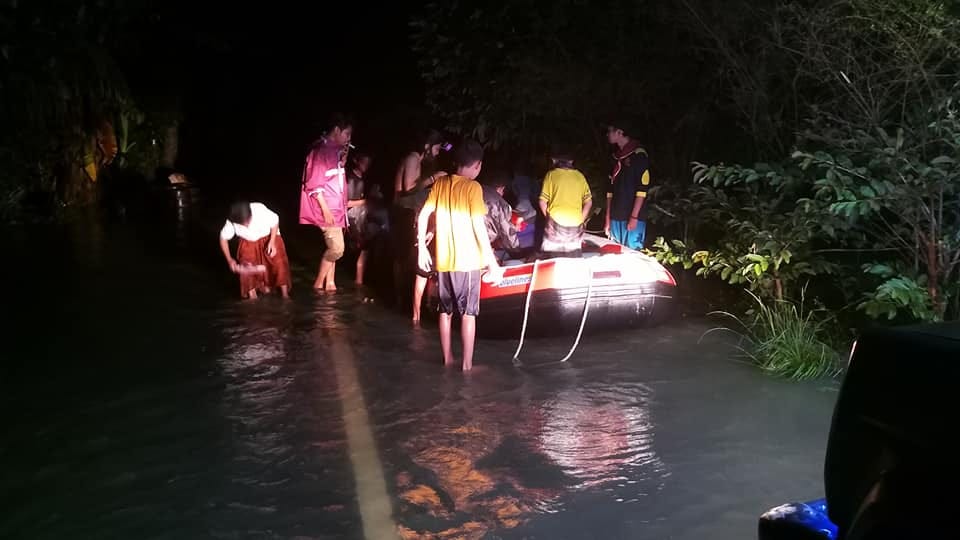#57 - Killer floods in South Kalimantan: When mining and climate change mix
By Johanes Hutabarat and Aryo Bhawono in Jakarta, Indonesia
In January 2021, Rahmad Mulyadi decided to flee his house, along with his family, after seeing his two daughters shivering in their bed due to strong winds and the gush of cold floodwater. Incessant rains had caused massive flooding, and knee-deep water had reached their house.
“I did not dare see my daughters shivering," the 49-year-old farmer told us by phone.
Limamar Village, in Astambul District, where Mulyadi lives, was one of the areas in South Kalimantan most affected by the flooding. Outside Mulyadi’s house, water rose to waist level as rains continued nonstop for two days.
The floods killed 21 people and forced more than 20,000 residents to flee their homes. Mulyadi and his family evacuated to Banjarbaru city, an hours drive from his village. They stayed for 12 days at the shelter. Banjarbaru was one of just a few local cities that were not ravaged by the flash floods.
Mulyadi said that flash floods are not something common in his village. The last time they happened was 14 years ago, in 2006, he says. At that time, the water level went no higher than their knees.
When flash floods happened for about three straight days in January this year, rainfall reached 300 mm/day, exceeding the extreme limit of 150 mm/day, according to data released by Indonesia's Meteorology, Climatology and Geophysics Agency (BMKG). The average rainfall in January in the area last month reached a staggering 394 mm/day.
Indroyono Soesilo, previously director of fisheries and aquaculture resources at the UN’s Food and Agriculture Organisation (FAO) and now deputy senior minister for Indonesia’s welfare ministry, wrote back in 2014 how global warming could affect the country’s precipitation patterns.
“Global warming takes its course in Indonesia with surface temperatures increasing from 0.2 to 0.3C per decade,” he wrote. “This impacts precipitation patterns, causing a wetter climate in Sumatra and Kalimantan but drier seasons in Java, Bali and Nusa Tenggara. Decreased rainfall during critical times of the year may increase high drought risk, while increased rainfall during already wet times of the year may lead to high flood risk.”
Arie Rompas, the leader of forest campaigners of Greenpeace Indonesia, said South Kalimantan among the many parts of the earth where the climate has drastically changed. Conversion including deforestation has worsened the impact of climate change.
“The heavy rainfall comes while the environment is deteriorating due to massive exploration by palm plantation and mining industry and farming activities,” he says. “The environment can not contain the water.”
Forests and mining
Indonesia, one world’s top carbon emitters in large part due to its land-use emissions, has also continued to aggressively promote mining, an industry which experts and environmental groups said has contributed to the decrease in Indonesia’s forest cover.
The Indonesian Forum for the Environment (Walhi), a non- government group, says that the forest area in South Kalimantan has declined because of mining. Kisworo Dwi Cahyono, executive director of Walhi in South Kalimantan, said there have been 814 mining pits dug by some 157 mining companies in this area. While some of the mining companies left already, many mining pits remain unreclaimed or not rehabilitated.
Overall, half of the 3.7 million hectares of land in South Kalimantan are controlled by mining or palm plantation companies.
“We have voiced that South Kalimantan is in an emergency of ecology disaster,” Cahyono said. “Fifty percent of the total land has been divided to this — 33% for mining, 17% for palm plantation.”
But the government seems to neglect or ignore this reality.
Lana Saria, the environmental director at the Indonesian Ministry of energy and mineral resources has defended the mining industry. In January, she argued that the 212 permits granted to mining companies in South Kalimantan covers no more than 14% of South Kalimantan’s land.
“Land clearing in South Kalimantan happened just on a small scale,” she said.
Indonesia’s president Joko Widodo also did not mention deforestation in his response to the disaster. He blamed 10 days of rainfall for the inability of the Barito river, the watershed in South Kalimantan, to contain the water.
In normal days, the river can contain 230 million cubic meter of water, he said. But the heavy rainfall in January exceeded 2.1 billion cubic meter of water, which was cited as the main cause of the flash floods in some areas in South Kalimantan.
Deforestation
Bambang Hero, a forestry expert from the Bogor Agricultural University, does not agree however. He said that extreme weather is just one of the factors that caused the floods in South Kalimantan. It was deforestation which compounded its effects, exacerbating the disaster.
He said that while heavy rainfall increased the water level in rivers, the flash floods in South Kalimantan ultimately showed that the Barito River watershed can no longer hold as much water as it used to because of reduced forest cover.
The Barito River watershed can usually take up 238 million cubic meters of water. But due to the high rain intensity, the river was overwhelmed with two billion cubic meters of water, the environment ministry said.
“I think it gives a glimpse of ecosystem interference in South Kalimantan, especially in its watershed area,” Hero tells us. “And the rain was just a trigger.”
Bambang referred to data from Indonesia's National Institute of Aeronautics and Space (LAPAN). The agency’s data shows the number of primary and secondary forest, shrubs and rice fields in the Barito river watershed area has shrunk in the last 10 years. An estimated 13,000 hectares of primary forest have been lost, and 116,000 hectares of secondary forest.
The government has recently changed its tune, the police have said they are now considering probing coal mining companies for their alleged contribution to deforestation.
But Mulyadi, who has come back to his house after staying 12 days at the shelter due to the disaster, said the government also needs to reclaim and reforest the areas used for open pit mining as soon as possible.
“If they are not reclaimed it will trigger other disasters.”
Johanes Hutabarat is a freelance journalist based in Jakarta. He writes about society and the environment.
Aryo Bhawono is a freelance journalist based in Jakarta. He writes about politics, corruption, and environment.
This post was funded by a climate investigation grant awarded to From A Climate Correspondent by the European Federation for Science Journalism (EFSJ) and funded by the BNP Paribas Foundation.
If you’d like to support us to publish more journalism from the front lines of climate change, please consider supporting us with a regular donation on Patreon or inviting us for a one-time coffee over at KOFI. You can also support use by signing up and sharing this article with others
Must reads from the region
The Consultants: Why did palm oil conglomerate pay $22m to unnamed expert in Papua?, The Gecko Project
A major investigation published last year looked into mysterious payments connected to a major land deal in Papua.
Fighting Fowl in Sulawesi, Eko Rusdianto, New Naratif
Chickens hold prestigious positions in Toraja, South Sulawesi. Their presence is embedded in local mythology and history, and cockfighting is not only a form of gambling but also part of important rituals and used for conflict resolution.
Fear and Loathing at Citarum's Ground Zero, Adi Renaldi, New Naratif
Along West Java’s longest river, the Citarum, chemical pollution, siltation and agriculture waste have made the waterway one of the world’s dirtiest. Those working on its banks say efforts are being made to clean it up.
What else I’m reading
I am reading "She Said". The book recounts how two investigative reporters of New York Times uncovered the scandal of sex abuse conducted by Hollywood's prominent producer, Harvey Weinstein.
Who we are
From A Climate Correspondent is a weekly newsletter exploring the climate crisis from around the globe run by four journalists. We regularly feature guest writers.
Lou Del Bello is an energy and climate journalist based in Delhi, India.
Jocelyn Timperley is a climate journalist based in San José, Costa Rica.
Purple Romero is a climate and human rights journalist based in Hong Kong.
Mat Hope is investigative journalist based in Nairobi, Kenya.
Been forwarded this email?
Did someone send this on to you? Why not sign up yourself!




